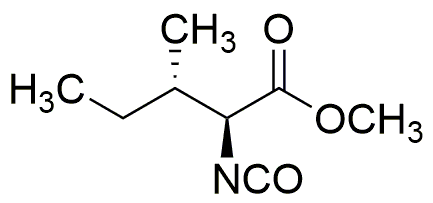Methyl (2S,3S)-2-isocyanato-3-methylvalerate is widely utilized in research focused on:
- Polymer Synthesis: This compound serves as a key intermediate in the production of specialty polymers, enhancing properties such as flexibility and durability in materials used in automotive and aerospace industries.
- Pharmaceutical Development: It is used in the synthesis of various pharmaceutical agents, contributing to the development of medications with improved efficacy and reduced side effects.
- Agricultural Chemicals: The compound plays a role in creating agrochemicals, such as herbicides and insecticides, which are designed to be more effective while minimizing environmental impact.
- Coatings and Adhesives: Its unique reactivity makes it valuable in formulating high-performance coatings and adhesives, offering better adhesion and resistance to harsh conditions compared to traditional compounds.
- Research Applications: In academic and industrial research, it is utilized to explore new chemical reactions and pathways, aiding in the discovery of novel materials and compounds.
General Information
Properties
Safety and Regulations
Applications
Methyl (2S,3S)-2-isocyanato-3-methylvalerate is widely utilized in research focused on:
- Polymer Synthesis: This compound serves as a key intermediate in the production of specialty polymers, enhancing properties such as flexibility and durability in materials used in automotive and aerospace industries.
- Pharmaceutical Development: It is used in the synthesis of various pharmaceutical agents, contributing to the development of medications with improved efficacy and reduced side effects.
- Agricultural Chemicals: The compound plays a role in creating agrochemicals, such as herbicides and insecticides, which are designed to be more effective while minimizing environmental impact.
- Coatings and Adhesives: Its unique reactivity makes it valuable in formulating high-performance coatings and adhesives, offering better adhesion and resistance to harsh conditions compared to traditional compounds.
- Research Applications: In academic and industrial research, it is utilized to explore new chemical reactions and pathways, aiding in the discovery of novel materials and compounds.
Documents
Safety Data Sheets (SDS)
The SDS provides comprehensive safety information on handling, storage, and disposal of the product.
Product Specification (PS)
The PS provides a comprehensive breakdown of the product’s properties, including chemical composition, physical state, purity, and storage requirements. It also details acceptable quality ranges and the product's intended applications.
Certificates of Analysis (COA)
Search for Certificates of Analysis (COA) by entering the products Lot Number. Lot and Batch Numbers can be found on a product’s label following the words ‘Lot’ or ‘Batch’.
Numéro de catalogue
Numéro de lot/série
Certificates Of Origin (COO)
This COO confirms the country where the product was manufactured, and also details the materials and components used in it and whether it is derived from natural, synthetic, or other specific sources. This certificate may be required for customs, trade, and regulatory compliance.
Numéro de catalogue
Numéro de lot/série
Safety Data Sheets (SDS)
The SDS provides comprehensive safety information on handling, storage, and disposal of the product.
DownloadProduct Specification (PS)
The PS provides a comprehensive breakdown of the product’s properties, including chemical composition, physical state, purity, and storage requirements. It also details acceptable quality ranges and the product's intended applications.
DownloadCertificates of Analysis (COA)
Search for Certificates of Analysis (COA) by entering the products Lot Number. Lot and Batch Numbers can be found on a product’s label following the words ‘Lot’ or ‘Batch’.
Numéro de catalogue
Numéro de lot/série
Certificates Of Origin (COO)
This COO confirms the country where the product was manufactured, and also details the materials and components used in it and whether it is derived from natural, synthetic, or other specific sources. This certificate may be required for customs, trade, and regulatory compliance.


